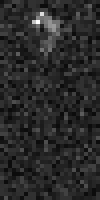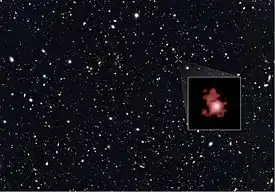2016 DV1
2016 DV1 is a near-Earth asteroid estimated to be roughly 29–65 meters (95–210 feet) in diameter. It is a fast rotating asteroid of the Apollo group which was first observed by the Mount Lemmon Survey on 28 February 2016, just days before it passed Earth at 1 lunar distance (LD) on 3 March 2016. The elongated fast rotator has a rotation period of 303 seconds. It has not been observed since March 2016 and only has a short observation arc of 4 days. It will approach Earth again around 2 March 2021 at a distance between 0.001 AU (0.39 LD; 150,000 km; 93,000 mi) and 0.02 AU (3,000,000 km; 1,900,000 mi).[3]
 Bistatic Solar System Radar image of 2016 DV1 on 3 March 2016. | |
| Discovery [1] | |
|---|---|
| Discovered by | MLS |
| Discovery site | Mount Lemmon Obs. |
| Discovery date | 28 February 2016 (first observation) |
| Designations | |
| 2016 DV1 | |
| NEO–Apollo [2][3] | |
| Orbital characteristics [3] | |
| Epoch 31 May 2020 (JD 2459000.5) | |
| Uncertainty parameter 6[3] · 3[2] | |
| Observation arc | 4 days |
| Aphelion | 3.0020 AU |
| Perihelion | 0.6810 AU |
| 1.8415 AU | |
| Eccentricity | 0.6302 |
| 2.50 yr (913 d) | |
| 232.91° | |
| 0° 23m 39.84s / day | |
| Inclination | 3.3743° |
| 161.69° | |
| 18 April 2021 | |
| 80.060° | |
| Earth MOID | 0.001 AU (0.39 LD; 150,000 km) |
| Physical characteristics | |
Mean diameter | 29–65 m (est. 0.25–0.05)[4][lower-alpha 1] 40 m (assumed 0.14)[5] |
| 0.084148±0.000005 h[6][7][lower-alpha 2] or 5.04888±0.0003 min | |
| 24.8[2][3] | |
Orbit
2016 DV1 orbits the Sun at a distance of 0.7–3.0 AU once every 2 years and 6 months (913 days; semi-major axis of 1.84 AU). Its orbit has a high eccentricity of 0.63 and an inclination of 3° with respect to the ecliptic.[3] It has an Earth minimum orbital intersection distance of 0.001 AU (0.39 LD; 150,000 km). Due to its eccentric orbit, 2016 DV1 is also a Mars-crosser, crossing the orbit of the Red Planet at 1.66 AU.[3]
2016 discovery
It was first observed by the Mount Lemmon Survey on 28 February 2016,[1] when the asteroid was about 0.04 AU (6,000,000 km; 3,700,000 mi) from Earth and had a solar elongation of 174°. The last optical image was at 3 March 2016 03:08 UT.[2] Bistatic Solar System Radar (GSSR) with DSS-13 and the Green Bank Observatory were used to image the asteroid.[8] It passed closest approach to Earth on 3 March 2016 05:17 UT at a distance of 0.00264 AU (1.03 LD; 395,000 km; 245,000 mi)[3] and was quickly approaching the glare of the Sun thus preventing further optical observations.[9]
2021 approach
The asteroid might be brighter than apparent magnitude 24 around early February 2021,[10][lower-alpha 3] which would place it near the limiting magnitude of even the best automated astronomical surveys. It should come to opposition (opposite the Sun in the sky) around 21–23 February 2021 at around magnitude 20.[10] During opposition, the uncertainty in the asteroid's sky position covers about 2° of the sky.[10] Around 2 March 2021 (±1 day),[lower-alpha 4] it is expected to pass between 0.001 AU (0.39 LD; 150,000 km; 93,000 mi) and 0.02 AU (3,000,000 km; 1,900,000 mi) from Earth.[3] The poorly constrained nominal approach is 0.01 AU (3.9 LD; 1,500,000 km; 930,000 mi) on 2 March 2021. The nominal approach has the asteroid brightening to magnitude 17–18 on 1 March 2021 (one day before closest approach).[10] It is not listed on the Sentry Risk Table because the line of variation (LOV) does not pass through where Earth will be.
Physical characteristics
Rotation period
In March 2016, a rotational lightcurve of 2016 DV1 was obtained from photometric observations by American astronomer Brian Warner at the Palmer Divide Station (U81) at the Center for Solar System Studies in California. Lightcurve analysis gave a well-defined rotation period of 0.084148±0.000005 hours (or 302.9 seconds) with a high brightness variation of 0.56±0.04 in magnitude, indicative of an irregular shape (U=3).[7][lower-alpha 2] On the following night, European astronomers Siegfried Eggl, William Thuillot, Maria Kudryashova, and Raoul Behrend determined a similar period of 0.08435±0.00005 hours (or 303.7 seconds) and an even higher amplitude of 1.02±0.03 magnitude.(U=3).[11]
Diameter
The diameter can only be estimated. Based on a generic absolute magnitude-to-diameter conversion, 2016 DV1 measures approximately 40 meters (130 feet) in diameter given an absolute magnitude of 24.8 and an assumed albedo of 0.14.[4][5] Since the near-Earth population shows a bimodal distribution with two albedo-peaks at 0.25 and 0.05, 2016 DV1 may measure 29–65 meters (95–210 feet) in diameter,[lower-alpha 1] for a corresponding stony and carbonaceous composition, respectively.
Notes
- CNEOS lists a generic size range of 29–65 meters (95–210 feet) which would be an average size of 47 meters (150 feet).
- Warner (2016) lightcurve plot of 2016 DV1 rotation period 0.084148±0.000005 hours with a brightness amplitude of 0.56±0.04 mag. Quality code: 3. Summary figures at the Center for Solar System Studies and at the LCDB
- Do not confuse the fixed value of absolute magnitude (H) with the variable value of apparent magnitude. Absolute magnitude is how bright the object would be if it was both 1 AU from Earth and the Sun, and is useful for estimating the diameter of the object. Apparent magnitude is how bright the object is on a given date/time.
- With a 4 day observation arc, the JPL Small-Body Database for 2021-Mar-02 shows the "Time Uncertainty" as 17:16 which is 17 hours and 16 minutes.
References
- "MPEC 2016-D64 : 2016 DV1". IAU Minor Planet Center. 29 February 2016. Retrieved 12 September 2020. (K16D01V)
- "2016 DV1". Minor Planet Center. Retrieved 12 September 2020.
- "JPL Small-Body Database Browser: (2016 DV1)" (2016-03-03 last obs.; arc: 4 days). Jet Propulsion Laboratory. Retrieved 12 September 2020. (archive 09 Sep 2020)
- "Asteroid Size Estimator". CNEOS NASA/JPL. Retrieved 12 September 2020.
- "2016DV1 - Physical properties". esa. Retrieved 13 September 2020.
- "LCDB Data for (2016+DV1)". Asteroid Lightcurve Database (LCDB). Retrieved 12 September 2020.
- Warner, Brian D. (July 2016). "Near-Earth Asteorid Lightcurve Analysis at CS3-Palmer Divide Station: 2016 January-April" (PDF). Minor Planet Bulletin. 43 (3): 240–250. Bibcode:2016MPBu...43..240W. ISSN 1052-8091. PMID 32539024.
- https://ssd.jpl.nasa.gov/dat/radar_data_ast.txt
- "2016DV1 Ephemerides for 3 March 2016". NEODyS (Near Earth Objects – Dynamic Site). Archived from the original on 13 September 2020. Retrieved 13 September 2020.
- "2016DV1 Ephemerides for February-March 2021". NEODyS (Near Earth Objects – Dynamic Site). Archived from the original on 12 September 2020. Retrieved 12 September 2020.
- Behrend, Raoul. "Asteroids and comets rotation curves – 2016 DV1". Geneva Observatory. Retrieved 12 September 2020.
External links
- 2016 DV1 at NeoDyS-2, Near Earth Objects—Dynamic Site
- Ephemeris · Obs prediction · Orbital info · MOID · Proper elements · Obs info · Close · Physical info · NEOCC
- 2016 DV1 at ESA–space situational awareness
- 2016 DV1 at the JPL Small-Body Database
- DSS13-GBT Radar Images of 2016 DV1


